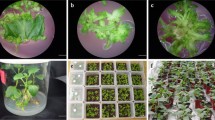Abstract
Shoots of rose (hybrid tea) cv. “First Prize” were induced to flower in vitro on Murashige and Skoog (MS) medium containing various sucrose concentrations (15, 30 or 45 g l−1) and different phytohormone combinations of different cytokinins [N6-benzyladenine (BA); thidiazuron (TDZ) and zeatin] with α-naphthaleneacetic acid (NAA). Results indicate that sucrose is the key factor in floral morphogenesis while cytokinin increases the flowering percentage and helps the normal development of floral buds. From the three cytokinins that were used, BA and zeatin were considered to be more suitable as inductive flowering agents than TDZ. Reduced inorganic and organic salt concentration in MS media had a positive effect on in vitro flowering. The morphology of shoots bearing floral buds varied with different cytokinin treatments. The highest percentage (45%) of flowering was obtained on MS medium supplemented with 3.0 mg l−1 BA, 0.1 mg l−1 NAA and 30 g l−1 sucrose.
Similar content being viewed by others
Abbreviations
- BA:
-
N6-benzyladenine
- TDZ:
-
Thidiazuron
- NAA:
-
α-Naphthaleneacetic acid
- MS:
-
Murashige and Skoog
- PGR:
-
Plant growth regulator
References
Al-Wareh H, Trolinder NL, Goodin JR (1989) In vitro flowering of potato. HortScience 24: 827–829
Bernier G, Havelange A, Houssa C, Petitjean A, Lejeune P (1993) Physiological signals that induce flowering. Plant Cell 5: 1147–1155
Dielen V, Lecouvet V, Dupont S, Kinet JM (2001) In vitro control of floral transition in tomato (Lycopersicon esculentum Mill.), the model for autonomously flowering plants, using the late flowering uniflora mutant. J. Exp. Bot. 52: 715–723
Duncan DB (1955) Multiple range and multiple F test. Biometrics 11: 1–42
Franklin G, Pius PK, Ignacimuthu S (2000) Factors affecting in vitro flowering and fruiting of green pea (Pisum sativum L.). Euphytica 115: 65–74
Ibrahim R, Debergh PC (2001) Factors controlling high efficiency adventitious bud formation and plant regeneration from in vitro leaf explants of roses (Rosa hydrida L.). Sci. Hort. 88: 41–57
Ignacimuthu S, Franklin G, Melchias G (1997) Multiple shoot formation and in vitro fruiting of Vigna mungo L. Hepper. Curr. Sci. 73: 733–735
Jumin HB, Nito N (1995) Embryogenic protoplast cultures of orange Jessamine (Murraya paniculata) and their regeneration on plant flowering in vitro. Plant Cell Tiss. Org. Cult. 41: 277–279
Jumin HB, Nito N (1996) In vitro flowering of Fortunella hindsii (Champ.). Plant Cell Rep. 15: 484–488
Kim KC, Oh JY, Jee SO, Chung JD (2003a) In vitro micropropagation of Rosa hybrida L. J. Plant Biotech. 5: 115–119
Kim KC, Chung JD, Jee SO, Oh JY (2003b) Somatic embryogenesis from in vitro grown leaf explants of Rosa hydrida L. J. Plant Biotech. 5: 161–164
Kintzios S, Michaelakis A (1999) Induction of somatic embryogenesis and in vitro flowering from inflorescences of chamomile (Chamomilla recutita L.). Plant Cell Rep. 18: 684–690
Kostenyuk I, Oh BJ, So IS (1999) Induction of early flowering in Cymbidium niveomarginatum Mak in vitro. Plant Cell Rep. 19: 1–5
Lee HS, Yang SG, Liu JR, Lee KW (1989) The control of in vitro flowering of ginseng (Panax ginseng C.A. Meyer) by growth regulators. Kor. J. Bot. 32: 255–264
Lin CC, Lin CS, Chang WC (2003) In vitro flowering of Bambusa edulis and subsequent plantlet survival. Plant Cell Tiss. Org. Cult. 72: 71–78
Lin CS, Lin CC, Chang WC (2004) Effect of thidiazuron on vegetative tissue-derived somatic embryogenesis and flowering of bamboo Bambusa edulis. Plant Cell Tiss. Org. Cult. 76: 75–82
Murashige T, Skoog F (1962) Revised medium for rapid growth and bioassays with tobacco tissue cultures. Physiol. Plant. 15: 473–497
Rastogi R, Sawhney VK (1986) In vivo culture of young floral buds of tomato (Lycopersicon esculentum Mill.). Plant Sci. 47: 221–227
Roberts AV, Blake PS, Lewis R, Taylor JM, Dunstan DI (1999) The effect of gibberellins on flowering in roses. J. Plant Growth Regul. 18: 113–119
Scorza R (1982) In vitro flowering: a review. HortScience 4: 106–127
Scorza R, Janick J (1980) In vitro flowering of Passiflora suberosa L. J. Am. Soc. Hort. Sci. 105: 892–897
Teixeira da Silva JAT, Nhut DT (2003) Thin cell layers and floral morphogenesis, floral genetics and in vitro flowering. In: Nhut DT, Le BV, Van TT, Thorpe T (eds). Thin Cell Layer Culture System: Regeneration and Transformation Applications. Kluwer Academic Publishers, Dordrecht, The Netherlands, pp. 285–342
Tran Thanh Van M (1973) In vitro control of de novo flower, but, root, and callus differentiation from excised epidermal tissues. Nature (Lond.) 246: 44–45
Van Staden J, Dickens CWS (1991) In vitro induction of flowering and its relevance to micropropagation. In: Bajaj YPS (ed). Biotechnology in Agriculture and Forestry, vol 17: High-tech and Micropropagation. Springer, Berlin, Heidelberg New York, pp. 85–115
Wang GY, Yuan MF, Hong Y (2002) In vitro induction in roses. In vitro Cell. Dev. Biol. Plant 38: 513–518
Wang S, Tang L, Chen F (2001) In vitro flowering of bitter melon. Plant Cell Rep. 20: 393–397
Werner T, Motyka V, Strnad M, Schmulling T (2001) Regulation of plant growth by cytokinin. Proc. Natl Acad. Sci. USA 98: 10487–10492
Wittwer SH, Aung LH (1969) Lycopersicon esculentun Mill. In: Evans LT (ed). The Induction of Flowering: Some Case Histories. Macmillan, London, pp. 409–429
Zhang Z, Leung DWM (2000) A comparison of in vitro with in vivo flowering in Gentian. Plant Cell Tiss. Org. Cult. 63: 223–226
Author information
Authors and Affiliations
Corresponding author
Rights and permissions
About this article
Cite this article
Vu, N.H., Anh, P.H. & Nhut, D.T. The role of sucrose and different cytokinins in the in vitro floral morphogenesis of rose (hybrid tea) cv. “First Prize”. Plant Cell Tiss Organ Cult 87, 315–320 (2006). https://doi.org/10.1007/s11240-006-9089-z
Received:
Accepted:
Published:
Issue Date:
DOI: https://doi.org/10.1007/s11240-006-9089-z




